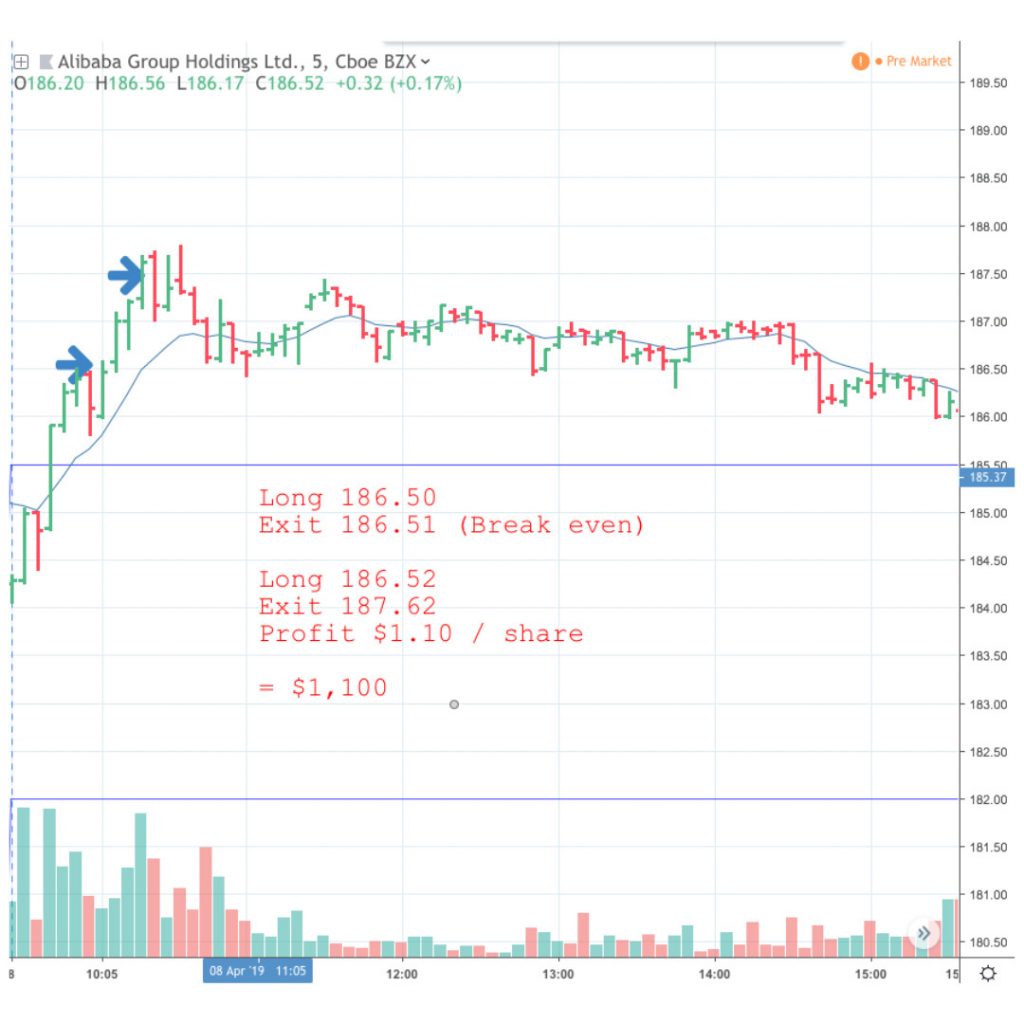Here’s a trade that went wrong from the off:

It all started out so well. The setup was good and it looked like there was some momentum, but the price hesitated. My rule is if it doesn’t go well right away, get out. There’s no point hanging around to see if it will come good, because most of the time it won’t. I jumped ship with a single cent profit, which covered half the commission.
In this case the trade did eventually come good, and I went back in just a cent higher than I’d previously got out. This time there was no hanging around, momentum was there, and I rode it up for more than a dollar, thus taking more than a thousand dollars profit on BABA.
Emergency Exits
People quite often tell me they get killed in the market by being stopped out all the time. And almost equally as often they tell me that the trade they were stopped out of then turned around and became a winner, except they were no longer on board, adding insult to injury. They ask me if they are choosing bad stocks.
The thing is, you can’t really choose a bad stock as such, just a bad entry. Sure, if you pick the ‘right’ stocks you will find a higher rate of good entries coming your way, but even a poorly chosen stock can present a good entry. Just as a theoretically excellent stock can offer a bad one.
The problem these traders have is that they are waiting for their stop loss order to be hit. Stop loss orders are an essential tool for the day trader, and wherever possible I recommend having a stop automatically placed by our trading software as soon as our entry order is filled. But the job of that stop order is to be our emergency exit. It’s like an airbag in a car — a last line of defence if we lose control. If we are driving at high speed and see a collision ahead, we wouldn’t keep our foot on the gas and assume the airbag will save us, we would at least try and brake to stop the car before we hit the obstacle. The airbag is only there in case the brake doesn’t work, or if we cannot stop in time.
The stop loss order is the day trader’s airbag. It’s there to take us out of a trade if we lose our internet connection, or if our computer crashes before we end the trade, or if there’s some other kind of problem that means we are no longer in control. But as long as we are in control, we don’t want to rely on that stop order. If a trade doesn’t work out the way we envisage, there is no point waiting for the stop to get hit. We should always try to exit ourselves, and do so quickly with the minimum possible loss.
In the above trade, I was out with a 1 cent profit. That’s $10 on 1000 shares, so in reality a $10 loss once commission is taken into account. Had I waited for my stop loss order to be hit, I’d be looking at a $50 loss at least, which would be $70 after commissions. I could take a $10 loss on every core stock on my watchlist and still be better off than taking a single $70 loss! What’s more, I only need to make a tiny profit on one trade to easily cover my tiny loss. But if I rely on my stop and accept the bigger loss, I’m on the back foot with a defecit to try to recoup.
Having taken that tiny loss on BABA, the tape showed renewed momentum and the price made another break for it. There was no reason not to enter again, so in I went. Had I been burned by a larger intial loss, I might have hesitated on taking the second entry. But having got out quickly for essentially break-even, there was no reason to hold back.
Keeping losses small by exiting at the first sign of trouble means that we get to keep our account balance intact, it takes the pressure off trying to win back a large loss, and it means we can take multiple entries without hesitation or fear of the risk. Stop orders are for emergencies only.